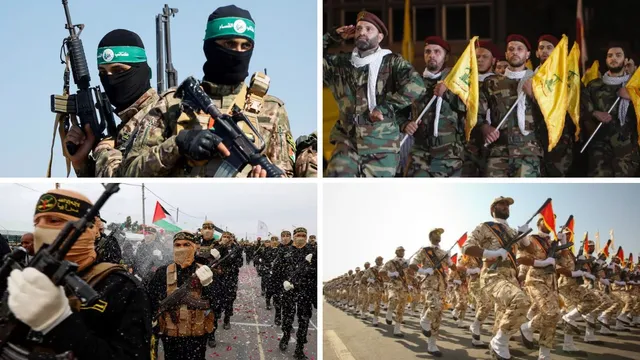- By Kamal Kumar
- Fri, 02 Aug 2024 05:05 PM (IST)
- Source:JND
Axis Of Resistance: After top Hamas leader Ismail Haniyeh was killed in an Israeli precision missile strike in Tehran, Iran has called a meeting of the Axis of Resistance - its regionally allied militias from Yemen to Syria - to prepare a robust retaliation against Tel Aviv. This comes after Hamas and allies such as Hezbollah witnessed the killing of its top rung of military and civilian leadership last month.
Earlier, Prime Minister of Israel Benjamin Netanyahu had declared his intention to continue and finish the existential war against the Axis Of Resistance. The current conflict which erupted on October 7, last year, has seen multiple fallouts with many regional militias involved in the fight against Israel.
Here's a list of groups which are part of 'Anti-Israel' Axis Of Resistance
Axis of Resistance is an 'informal' Iran-led political and military alliance in West Asia and North Africa. The Axis of Resistance notably includes the Islamic Resistance in Iraq, the Syrian government, the Lebanese political party and militant group Hezbollah, the Yemeni political and military organization Ansar Allah (also known as the Houthis), Hamas, and various other Palestinian militant groups.
Here's a brief on Axis Of Resistance Militias
Hamas: Founded in 1987 during the first Palestinian intifada, Hamas is an offshoot of the Muslim Brotherhood of Egypt. It was designated as a terrorist organisation by the United States and the European Union while it claimed to have represented the people of Palestine in their war against the illegal occupation of the unrecognised country. Before the war broke out in 2023, Hamas had around 20,000 fighters.
Islamic Jihad: Backed financially and militarily by Iran, this Sunni militant group has been active in Palestine and Gaza since its foundation in 1981. Though smaller than Hamas with only 1,000 members, Islamic Jihad is closer to Iran due to Tehran's ambition to establish a foothold in the occupied Palestinian territories.
Hezbollah: Translates to 'The Party of Allah', Hezbollah was founded in 1982 during the Israel-Lebanon conflict. The paramilitary militia has tried to unite the several Lebanese Shiite militant groups into a unified organisation. Hezbollah's leaders drew inspiration from Ayatollah Khomeini, and its military units were trained and organised by members of the Islamic Revolutionary Guard Corps. This well-armed group adheres to Iranian Shiite Islamist principles and is often regarded as more powerful than the Lebanese state.
Houthis: Formed in 1992, the movement took control of much of Yemen during the civil war that began in 2014, when it captured Sanaa and overthrew the Saudi-backed government. They belong to the Zaydi sect of Shiite Islam. On October 31, they announced that they had entered the conflict between Israel and Gaza by launching drones and missiles toward the Jewish state and into the Red Sea against all US and British merchant ships and warships participating in the "aggression."
Islamic Resistance in Iraq: An umbrella group that brings together several armed Shiite Islamist factions, it has been responsible for several attacks against U.S. forces in Iraq and Syria, the deadliest of which was on January 28, when a drone killed three American soldiers at a border base in Jordan. The United States responded with heavy retaliatory air strikes against Iran-linked targets in Syria and Iraq.
Syria: The government of President Bashar al-Assad is part of the Axis of Resistance but has not played a direct role in the current conflict.
(With IANS Inputs)

